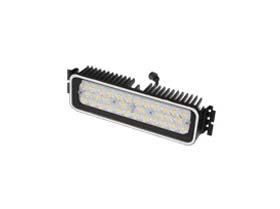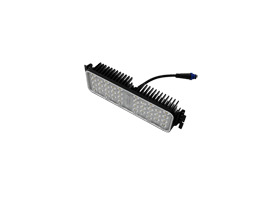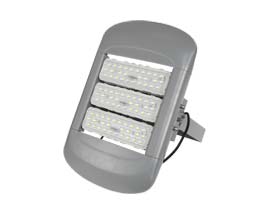How Does LED Tunnel Light Realize Resource Saving in Tunnel Lighting?
To save energy, improve lighting effects and ensure driving safety and comfort in tunnel lighting, the following aspects can usually be considered:
1. The brightness of LED tunnel lights
Since the brightness outside the tunnel during the day is much higher than that inside the tunnel, when the driver drives into the tunnel, the vision needs to have a certain adaptation time before he can see the inside of the tunnel. This phenomenon is called "adaptation lag phenomenon" "If there is no proper transition, a black hole phenomenon will occur, causing the driver to temporarily lose normal visual function, which will bring certain safety hazards. The black hole phenomenon is a visual problem that occurs before entering a tunnel, and it is also the most important problem in tunnel lighting.
For this reason, tunnel LED tunnel lighting is usually divided into entrance lighting, interior lighting and exit lighting. The brightness of the tunnel entrance lighting during the day should be determined according to the brightness outside the tunnel, the speed of the vehicle, the field of view at the entrance and the length of the tunnel. The threshold segment is to eliminate the "black hole" phenomenon, and the lighting level in the transition segment is further gradually decreased, thereby providing the driver with time for visual dark adaptation.
2. The brightness uniformity of LED tunnel lights
Good visual function not only requires a good average brightness, but also requires that the average brightness on the road surface and the minimum brightness should not be too different. If the brightness difference in the field of view is too large, the bright part will form a glare light source, and the change of brightness and darkness will bring a certain stroboscopic effect, which will affect the vision. Fatigue can also increase.
The overall brightness uniformity U0 refers to the ratio of the minimum brightness to the average brightness on the road surface in the inner section of the tunnel, and the longitudinal uniformity U1 refers to the ratio of the minimum road brightness to the maximum road brightness on the lane axis. If there are continuous and repeated bright and dark bands on the road surface, the "zebra effect", it will be very annoying for road users traveling in this lane. This problem involves human psychology, but also endangers road safety. The longitudinal uniformity is mainly used to evaluate the size of the "zebra effect".
3. The glare of LED tunnel lights
The formation of glare is due to the existence of extremely high brightness or brightness contrast in the field of view, which reduces visual function or makes the eyes feel uncomfortable. Glare in tunnel lighting can come from oncoming vehicle headlights, tunnel lighting fixtures, high brightness outside at tunnel exits, and the like. Glare will reduce people's ability to recognize obstacles and endanger driving safety.
Tunnel lighting should be of the cut-off type, and special technical measures to eliminate direct and reflected glare should be adopted to form diffuse reflection, so that the light can enter the human eye very softly.
4. The stroboscopic effect of LED tunnel lights
Strobe means that in a long tunnel, due to the discontinuous arrangement of the illuminators, the driver is constantly stimulated by the change of light and shade, and is disturbed. It is related to the brightness change of light and dark, the frequency of light and dark change, and the total time of stroboscopic. These three are related to the optical characteristics of the lamps used, the travel speed of the vehicle, the installation distance of the lamps, and the length of the tunnel. Generally speaking, when the frequency of strobe is less than 2.5 and greater than 15Hz, the LED tunnel lighting stroboscopic phenomenon is acceptable.
5. Lighting control of LED tunnel lights
The advanced lighting control method is an important technique for reasonable energy saving while ensuring the visual conditions and meeting the tunnel lighting requirements. The purpose of the lighting control is to be able to change the lighting level of the tunnel at any time.
Due to cloudy, rainy or twilight, the brightness outside the tunnel entrance is much lower than usual, so appropriate measures should be taken to reduce the level of lighting at the entrance to reduce unnecessary energy waste. In tunnel lighting, the illuminance of the tunnel lighting environment or the opening and closing of lights can be adjusted and controlled through various dimming devices or control devices according to factors such as day, night, and traffic flow.
At present, most of the foreign countries use photosensitive devices, dimmable electronic rectifiers, etc. to form an intelligent lighting system, which reduces the overall brightness of the lamps in the tunnel and reduces the energy consumption; at the same time, the uniformity of the tunnel brightness is kept unchanged.
The shell of the LED tunnel light is made of environmentally friendly alloy materials with high strength and good toughness. The transparent part is reinforced tempered glass, which is dust-proof, waterproof, corrosion-resistant and rust-resistant. It has strong anti-strong collision and impact ability; multi-channel shock-proof structure and high-tech surface spraying treatment, various close-range high-intensity high-frequency vibrations cannot affect the lamps, and it can work stably for a long time in high frequency vibration and humid and high temperature environments such as workshops, roadbeds, and rails. It has good electromagnetic compatibility, and will not cause interference to the power transmission network.
 English
English  中文
中文
 日本語
日本語
 Deutsch
Deutsch
 Türkçe
Türkçe



